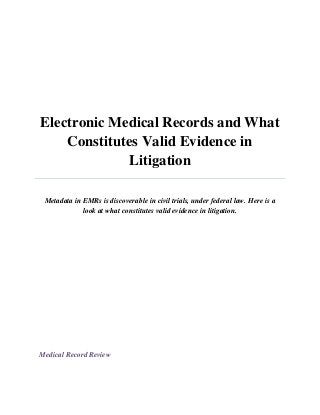
Electronic Medical Records and What Constitutes Valid Evidence in Litigation
- 1. Electronic Medical Records and What Constitutes Valid Evidence in Litigation Metadata in EMRs is discoverable in civil trials, under federal law. Here is a look at what constitutes valid evidence in litigation. Medical Record Review
- 2. www.mosmedicalrecordreview.com 1-800-670-2809 With paper records making way for electronic records, there is a change in medical record keeping and a corresponding change in what constitutes evidence in litigation and how information may become evidence in litigation. It is important therefore that attorneys who may need to review medical records understand HIPAA compliance with regard to EMRs, what electronically stored information is discoverable and admissible in court, and metadata. PHI (Protected Health Information) is any individually identifiable health information that is transmitted by and maintained in electronic media, or transmitted/maintained in any other form or medium. In other words, electronically stored information (ESI) constitutes PHI. ESI can be contained in electronic media (television, radio, internet, etc.), as well as electronic storage devices such as diskettes, flash drives, CD/DVD, and magnetic tape. In medical litigation PHI maintained in any electronic storage device or transmitted by any electronic media are possible sources of discoverable information. It is important to be aware of the fact that more than 50% of physicians use PDAs and smartphones on a regular basis in clinical decision making. In this scenario, attorneys and lawyers must have a clear idea regarding what is “discoverable.” Under HIPAA, PHI is protected with both a Privacy Rule and a Security Rule. These rules insist on certain safeguards and standards that will ensure that covered entities protect both paper and electronic medical records of a patient from unauthorized access, destruction or tampering. They should have procedures in place to provide individuals with a clear and accurate account of any PHI disclosures in case an accounting is necessary. Attorneys who want to obtain PHI from providers during discovery must do so by using either written authorization or subpoena. The terms “confidentiality” and “integrity” are of great significance with regard to HIPAA – the former implies that the data/information is not disclosed to unauthorized persons or processes; while the latter signifies that the data/information is not altered or destroyed in an unauthorized manner. Audit controls such as software, hardware and/or procedural mechanisms that record and examine activity in information systems that contain or use electronic PHI should be used by covered entities. Regular review of records of information system activity such as security tracking reports, access reports and audit logs is indispensable. Audit control systems generate metadata that comprises information about who accessed patient data, how it was used, and also regarding the operation of the electronic device storing or transmitting the medical records. This metadata is not part of the formal medical chart but is a rich storehouse of information that is not otherwise available in discovery. Audit trails give information regarding who accessed healthcare data, when, where, why and how it was accessed. This is very important from the point of view of testimony provided in the court and will help address any inconsistencies.
- 3. www.mosmedicalrecordreview.com 1-800-670-2809 Electronic medical records ensure increased availability of data and documentation for malpractice, personal injury and other cases. Digital data is more detailed, organized and clear. Metadata in electronic medical records is discoverable in civil trials, under federal law. The extent to which it is discoverable may however, vary from one state to another. Legal professionals involved in medical litigation need to be aware of the various rules and regulations pertaining to electronic data – the HITECH Act, HIPAA changes, DHHS Privacy Rule and Security Rule and the efficiencies of computer forensics that pertains to legal evidence found in computers and other digital storage media.
